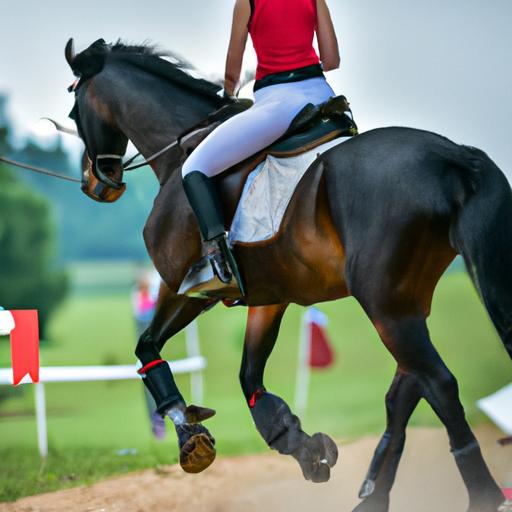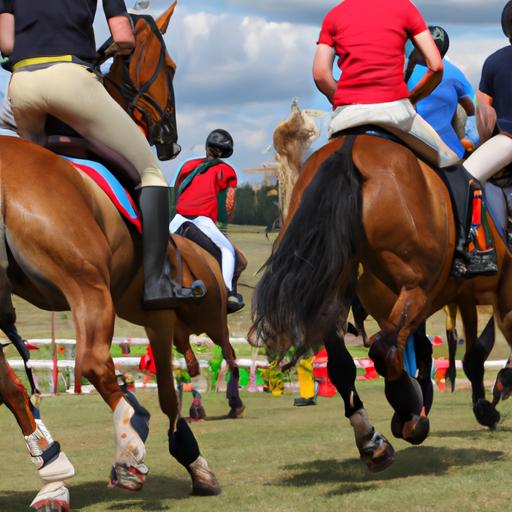Unleash the thrill of trec horse competition! Enhance your horse-rider relationship, develop problem-solving skills, and promote horsemanship and versatility.
Introduction

Have you ever wondered what it takes to navigate through challenging terrains while maintaining perfect control over your horse’s paces? Look no further than the exhilarating world of TREC horse competition! In this article, we’ll delve into the captivating realm of TREC, exploring its origins and shedding light on the exciting challenges it presents.
What is TREC?
TREC, which stands for Techniques de Randonnée Equestre de Compétition (Equestrian Trekking Competition Techniques), is a thrilling equestrian sport that tests the skill, agility, and partnership between horse and rider. Developed in France in the 1970s, TREC combines elements of orienteering, cross-country riding, and obstacle negotiation, making it a comprehensive test of horsemanship.
Brief History of TREC Horse Competition
TREC’s inception can be traced back to the need for a practical and enjoyable way to train riders for long-distance treks. Over time, it evolved into a competitive sport, captivating equestrians worldwide with its unique challenges. From its humble beginnings in France, TREC has gained international recognition, attracting participants from various disciplines and backgrounds.
The competition encompasses three main phases: the Orientation Phase, Control of Paces Phase, and the PTV (Por Timed Variable) Phase. Each phase is designed to assess different aspects of horsemanship, including navigation skills, control of speed and rhythm, and obstacle negotiation. Riders must demonstrate their expertise in these areas to achieve success in TREC competitions.
So, saddle up and get ready to embark on an unforgettable equestrian adventure like no other. In the following sections, we’ll provide a detailed overview of TREC’s rules and regulations, explore the intricacies of each competition phase, offer valuable training tips, and highlight the numerous benefits of participating in TREC horse competitions. Let’s dive in!
Rules and Regulations of TREC Horse Competition
Overview of the Competition Format
When it comes to TREC horse competitions, understanding the rules and regulations is paramount for success. The format typically consists of three phases, each designed to evaluate specific skills and abilities. Let’s take a closer look at what each phase entails and how they contribute to the overall competition experience.
Explanation of the Different Phases Involved
Orientation Phase: Navigating the Unknown
In the Orientation Phase, riders face the challenge of navigating through unfamiliar terrains using maps and compasses. This phase tests your ability to plan routes, interpret topographic maps, and make strategic decisions within time constraints. It’s a thrilling test of your orienteering skills and your horse’s adaptability to different environments.
Control of Paces Phase: Precision in Motion
The Control of Paces Phase focuses on maintaining precise control over your horse’s speed and rhythm. Riders must demonstrate their ability to maintain consistent paces, such as walk, trot, and canter, while negotiating various obstacles. It requires a delicate balance between speed and accuracy, showcasing the horse and rider’s coordination and communication.
PTV (Por Timed Variable) Phase: Conquering Obstacles
The PTV Phase is where the true excitement lies, as riders tackle a series of obstacles that simulate real-life challenges encountered during treks. From crossing bridges to navigating narrow passages and jumping obstacles, this phase tests your horse’s agility, responsiveness, and your ability to overcome obstacles efficiently. Each obstacle is assigned a difficulty level, and points are awarded based on your performance.
Requirements for Participating Horses and Riders
To ensure fair competition and the safety of all participants, specific requirements must be met by both the horse and rider. Horses should be physically fit, sound, and well-trained, capable of performing the required tasks with confidence. Riders must possess adequate riding skills, a solid understanding of the rules, and appropriate safety gear. Additionally, horses and riders must meet any specific eligibility criteria set by the competition organizers.
By familiarizing yourself with the rules and regulations of TREC horse competitions, you’ll be better prepared to embark on this exhilarating journey. In the next section, we’ll delve into the details of each TREC competition phase, providing valuable insights to help you conquer the challenges that lie ahead.
TREC Horse Competition Phases Explained
TREC horse competitions are a thrilling combination of various phases that test the skills and abilities of both the horse and rider. Let’s explore each phase in detail to understand the challenges they present.
Orientation Phase
In the Orientation Phase, competitors are tasked with navigating through a predetermined route using only a map and compass. This phase tests the rider’s ability to read maps, interpret symbols, and make strategic decisions. The purpose of this phase is to showcase the rider’s orienteering skills and their ability to efficiently navigate unfamiliar terrain.
During the Orientation Phase, riders must not only determine the correct path but also estimate the time required to complete each section. This phase demands a fine balance between speed and accuracy, as riders aim to reach each checkpoint within the given time frame. Navigation techniques such as dead reckoning, triangulation, and following prominent landmarks are commonly employed to successfully complete this phase.
Control of Paces Phase
The Control of Paces Phase focuses on the rider’s ability to maintain control and regulate their horse’s speed and rhythm. This phase evaluates the rider’s understanding of their horse’s gaits and their capability to adapt to different terrains and obstacles. The importance of this phase lies in the demonstration of the rider’s harmonious partnership with their equine companion.
Riders must showcase their skill in adjusting the horse’s pace, transitioning smoothly between walk, trot, and canter when necessary. The objective is to maintain a consistent rhythm and speed throughout the designated course. Judges assess the rider’s ability to control the horse’s paces, respond to commands promptly, and exhibit harmony and balance.
PTV (Por Timed Variable) Phase
The PTV Phase is the heart of TREC horse competitions, where riders face a variety of obstacles that mimic real-life challenges encountered during equestrian treks. This phase tests the horse and rider’s agility, bravery, and problem-solving abilities. The obstacles can include water crossings, narrow bridges, gates, and simulated natural hazards.
Competitors must navigate through these obstacles while adhering to specific rules and guidelines. Each obstacle is judged based on criteria such as accuracy, control, and overall performance. The rider’s ability to demonstrate calmness, horsemanship, and efficient negotiation of the obstacles plays a crucial role in scoring points.
With these diverse phases, TREC horse competitions offer an exciting and comprehensive evaluation of horsemanship skills. From navigation prowess to precise control of paces and obstacle negotiation, riders must demonstrate their versatility and competence in each phase to secure success in TREC competitions.
Training Tips for TREC Horse Competition
Fitness and Conditioning: Preparing for the Ultimate Challenge
To excel in TREC horse competitions, both you and your equine partner must be in top physical condition. Building endurance and strength is crucial for navigating through long treks and overcoming demanding obstacles. Incorporate regular exercise routines that include cardio workouts, interval training, and hill work to enhance your horse’s fitness levels. Additionally, focus on maintaining a balanced diet and ensuring proper hydration to optimize performance.
Navigation and Map Reading Skills: Finding Your Way to Success
The Orientation Phase of TREC heavily relies on your ability to navigate through unfamiliar terrains using maps and compasses. Sharpen your map reading skills by familiarizing yourself with topographic maps and learning to interpret symbols and contours. Practice plotting routes, calculating distances, and estimating travel times. By honing your navigation skills, you’ll gain a competitive edge and enhance your confidence during the competition.
Obstacle Training and Desensitization Techniques: Conquering Challenges with Ease
The PTV Phase of TREC puts your horse’s agility and obedience to the test as you navigate a series of obstacles. Introduce your horse to a variety of obstacles, gradually increasing the difficulty level over time. Implement desensitization techniques to ensure your horse remains calm and focused in the face of challenging situations. Familiarize your equine partner with common obstacles such as bridges, water crossings, and gates, and practice maneuvering through them with precision.
Remember, successful training for TREC horse competitions requires consistent practice and patience. Gradually increase the difficulty of exercises and obstacles, always prioritizing your horse’s safety and well-being. By focusing on fitness, navigation skills, and obstacle training, you’ll be well-prepared to tackle the exhilarating challenges that lie ahead in the world of TREC. Stay tuned as we explore the numerous benefits of participating in TREC horse competitions in the next section.
Conclusion: The Thrill of TREC Horse Competition
TREC horse competitions offer an unparalleled opportunity for equestrians to engage in a thrilling adventure while enhancing their horsemanship skills. By participating in TREC, you not only embark on a journey of self-improvement but also forge a stronger bond with your equine partner.
Recap of the Unique Aspects of TREC
Throughout this article, we have explored the various facets of TREC horse competitions, from its origins as a training method to its evolution into a competitive sport. We have delved into the three main phases of TREC, emphasizing the importance of navigation skills, control of paces, and obstacle negotiation.
Encouragement to Participate
As an equestrian enthusiast, TREC competitions offer you an unparalleled platform to challenge yourself, develop problem-solving skills, and showcase your horsemanship and versatility. By participating in TREC, you become part of a vibrant community of like-minded individuals who share your passion for horses and the exhilaration of overcoming obstacles together.
So, whether you’re a seasoned rider looking for a new adventure or a beginner eager to test your skills, TREC horse competitions provide an avenue for personal growth, camaraderie, and unforgettable memories.
Join us at Horsemasterypro.com and take the reins of excitement as you dive into the world of TREC. Unleash your potential, strengthen your connection with your horse, and experience the thrill of conquering new challenges. It’s time to embark on your TREC journey and create memories that will last a lifetime.


